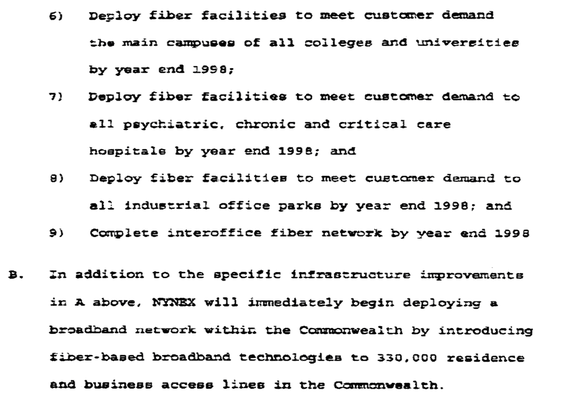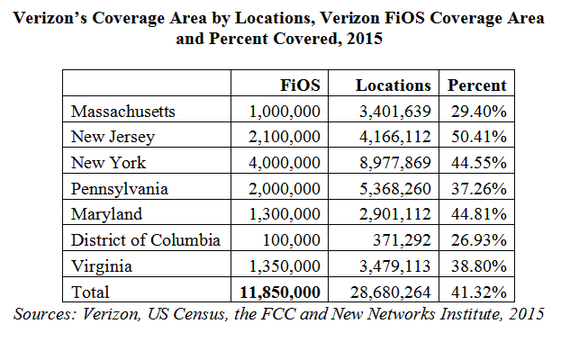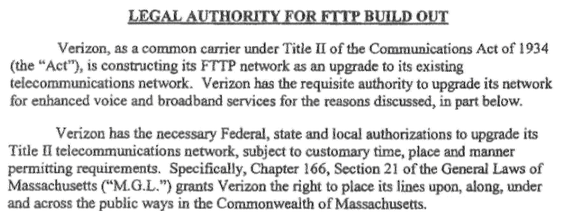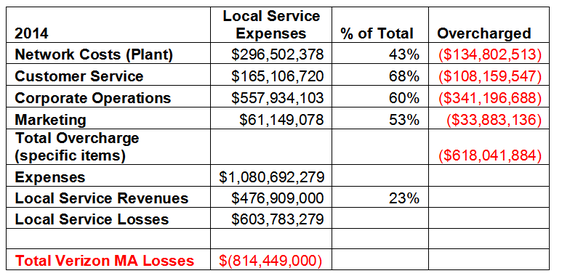NOTE: This article is from NNI's new report "Verizon Massachusetts & Boston: Investigate the Wireless-Wireline Bait-n-Switch"
Introduction
We have uncovered billions of dollars in questionable cross-subsidies between and among Verizon Wireless, (and Verizon's other subsidiaries) and Verizon Massachusetts, the state-based, wireline utility, that can be used to upgrade the Bay State's cities with fiber optics. Unfortunately, these financial manipulations of the accounting have gone unchallenged. In fact, this same shell game has been used throughout the Verizon territories.
As we previously noted and will discuss, while Verizon has claimed it will be upgrading the city of Boston with fiber optics, the real plan is to do a bait-n-switch and offer wireless... but have the wireline utility budgets pay for it.
And, instead of investigations, we have this: On January 9th 2017, a letter was filed with the FCC by the MA Department of Telecommunications and Cable and the MA Broadband Institute and it begs the FCC for federal government funding from the Connect America Fund.
According to Telecompetitor, Massachusetts joined other states who have requested CAF funding be made available to them directly as Verizon has turned down the funding. But it is embarrassing; the speed required, in 2017, is a minimum of 10 Mbps down-1 Mbps upstream ; it has data caps, and it is estimated that the funding would be chump change -somewhere around $5-$10 million, at best.
This article is from NNI's new report "Verizon Massachusetts & Boston: Investigate the Wireless-Wireline Bait-n-Switch" (and Part 2: Data Report) and is part of a series called "Fixing Telecom" . What we are about to expose in Massachusetts is identical to what has occurred in other Verizon states we documented, including Verizon New York.
Using Verizon New England and Verizon Massachusetts state-based financial reports, press releases and state and federal filings:
1) Verizon Claims It Is Now a 'Wireless-First' Company.
Verizon Communications, the holding company, has decided it is a wireless-first, entertainment and advertising company. Unfortunately, Verizon also controls the state-based wired utilities and business networks along the East Coast, from Massachusetts to Virginia, with only a few exceptions. Verizon has no serious plans to upgrade or even maintain the existing retail copper wires. Even Verizon's FiOS fiber to the home deployments stopped in 2010-2012, except for areas with existing license agreements.
2) Verizon Wireless has Diverted Billions Per State to Build Out Its Wireless Networks by having the Wireline State Utility Pay Most of the Capital Expenditures ("Capex") Budgets.
Starting in 2010, when Lowell McAdam, (former president of Verizon Wireless), was appointed the CEO of Verizon, the company decided that it would build out the wired network to be used for their cell sites. In just Massachusetts, from 2010 to 2012:
a)Verizon, the state wireline utility, built an estimated 2,265 major cell sites for the wireless company.
b)Verizon Wireless was able to have Verizon MA spend an estimated $976 million in construction expenses--and didn't reimburse the utility for this construction.
c)Verizon, the state utility, had 71% of the capx diverted to fund wireless from 2010-2012.
Let us be very clear. We believe Verizon, in Massachusetts, has systematically diverted over a billion dollars since 2010 from this state utility budget to build out the fiber optic wires that are used for Verizon Wireless to offer wireless service. I.e.; Verizon was able to have the Bay State utility customers pay over a billion, even though the investors should have been funding Verizon's wireless deployments.
NOTE: Verizon Wireless is a D/B/A and is owned by "Cellco Partners", which is the name of a former joint venture with Vodaphone, a foreign communications concern.
This meant that the entire state of Massachusetts's copper-based utility network was left to mostly deteriorate and the majority of the state, which Verizon New England controls, was never properly upgraded.
NOTE: Verizon New England is the incumbent, utility telephone company that controls the bulk of the wires in Massachusetts and Rhode Island.
3) "Title II" Is the Investment Mechanism to Fund these Massive Cross-Subsidies.
Moreover, the fiber to the cell sites, as well any of the "FTTP", fiber to the premises, FiOS services that have been deployed, were also funded by local phone customers, and this fiber optic wire is all part of the state utility. This occurred because Verizon claims that the fiber optic networks are "Title II", common carrier networks, as told by the Communications Act of 1934.
4) Verizon and its Minions Claim that Title II Harms Investment: Baloney. Title II is the Investment Mechanism.
Verizon and its paid 'experts', analysts, and lawyers want to erase 'Title II' on Net Neutrality as well as everywhere else, claiming that it harms investment. Unfortunately, the truth is - it is the investment method. Verizon has been able to cross-subsidize its other lines of business and Verizon and these experts have deceived the public-- or they did not bother to examine Verizon's filings in every territory claiming that the FiOS fiber to the home networks are simply an enhancement of the state utility. This con has allowed Verizon's other lines of business to get the use of the rights of way and to use the state utilities as a funding source.
5) Verizon Management Admitted that Wireless Networks are Paid for Via the Wireline Budgets.
Fran Shammo, Verizon's former CFO, told investors in 2012 that the wireless company's construction expenses have been charged to the wireline business.
"The fact of the matter is Wireline capital--and I won't get the number but it's pretty substantial--is being spent on the Wireline side of the house to support the Wireless growth. So the IP backbone, the data transmission, fiber to the cell, that is all on the Wireline books but it's all being built for the Wireless Company."
6) Verizon's Own Press Releases Detailed that the Wireline Construction Budgets Paid for the Fiber Optic Wires to the Cell Sites.
The data we use for both the wireline construction budgets used for the wireless networks as well as the number of cell sites, comes directly from Verizon's published information, including press releases. This was published in 2012, detailing the wireline capx in MA for 2011. And it details that Verizon wireline paid for construction of 815 cell site connections.
"Verizon Invested More than $500 Million in Massachusetts' Wireline Communications, IT Networks in 2011
"Accelerated deployment of fiber-optic links to wireless carriers' cell sites throughout Massachusetts as these carriers expand their infrastructure to meet ever-growing demand for wireless broadband and advanced 4G services. In 2011, Verizon deployed fiber optics to connect 815 of these sites in the state." (Emphasis added.)
7) Massive Financial Cross-Subsidies Go Unchallenged by the State Commission.
Diverting the state utility budgets is only one of the sleight-of-hands employed by Verizon. Using Verizon Massachusetts financial reports obtained via FIOA requests for the years 2012-2014, what we found is a multi-headed scheme to a) make the local utility networks look unprofitable, while b) at the same time funding other lines of business. And this is happening in every Verizon state.
NOTE: To see exactly how Verizon's state financial accounting works, and how these cross-subsidies are being accomplished, see the "Fixing Telecom" report series.
Overcharging of the 'Local Service' line of business and the cross-subsidizing of Verizon's other lines of business cost the local networks over $600 million in just 2014.
Verizon Massachusetts:
- In 2014, Verizon Massachusetts Local Service (which are the revenues for the basic copper-based phone service) was 23% of the revenues coming into the state utility, at $476 million.
However, Verizon Local Service:
- Paid 60% of all "Corporate Operations" expense. At $558 million, this is $81 million--119%-- more than the revenues. Corporate Operations includes lawyers, lobbying, executive pay, and even the corporate jet - all aimed at pushing Verizon's agenda nationwide.
If the expenses were based on revenues:
- Verizon Local Service was overcharged $618 million in just 2014.
But, there should be no marketing costs and little or no network costs, as most of the copper wires are not being upgraded or maintained. And charging Local Service excessive corporate operations expenses would not have been allowed if there was oversight by the state regulators.
Based on the actual expenses, local service prices should have been in steep decline over the last decade.
Thus, these calculations can't possibly be related to the actual expense of offering Local Service in Verizon Massachusetts--and they aren't. These costs/expenses are cross-subsidizing all of Verizon's other lines of business.
The arguments: Local Service is 'price cap'-ed, or deregulated or other statements indicating a lack of regulatory requirement or oversight must be put into perspective - These deregulatory actions were based on commitments never fulfilled, as we will discuss.
8) Verizon's Boston FiOS Fiber to the Home Deployment Is a Bait-n-Switch.
There is new wrinkle: Verizon is now claiming it has started again to roll out FiOS, fiber to the home services in Boston and will have the city completed in 6 years.
Verizon is not telling the citizens of Boston the truth. It has no intention of wiring the entire city with fiber optics to the home but has created a bait-and-switch, where it now plans to roll out 4G (and even lies about it being the 'newer 5G'). And, the plan -- it will be based on the same pricing as wireless--- pay by the gigabit. Worse, it will not have the speed or capabilities of fiber to the home and, at this point, the wireless service requires the fiber being put in, which is being paid for by local phone customers as Title II.
At the Oppenheimer 19th Annual Technology Internet Communications Conference, August 9th, 2016, Timothy Horan, Oppenheimer & Co. Analyst asked Verizon.
"So are you deploying fiber differently now in Boston than you've done for FiOS in the past? Does each small cell need like their own fiber home run to that small cell? Are you going to be deploying a lot more fiber than you have historically?"
David Small, Verizon Communications, Inc. EVP responded:
"Yes, we will. And so, as it relates to FiOS, we've announced a few of the suburb areas, for lack of a better word, for cities, sub cities that we are going to be building into. But beyond that, if you think about the use case for small cells and the coordination elements of the radio access network that need to occur between its corresponding home macro and the small cell, that suggests that, as a general rule, you need home runs from that small cell directly back to that coordinating macro-level cell site. And that's exactly what we are doing."
It is a shame that this explanation directly contradicts what Verizon has told the city of Boston.
9) Verizon Management Admits Wireless Replacement Is Done to 'Save Money', Not Building Utility Infrastructure.
Lowell McAdam, Verizon's CEO, claims that they will make more money with wireless.
"So if you think about it if I can get we than say a 1000 meters of a business and I give them a router, a basic router that has a 5G service inside it and I'm up and operating immediately, I mean, think about the difference for the carrier in the cost structure; half of our cost to establish high speed data whether it's consumer business is inside the four walls of the business.
"Once you go wireless, you don't have to run co-ax, you don't have to do any of those high labor intensive activities and so you light up service overnight. So then you get into how much capacity do you want and you can - the pricing models can change dramatically."
Thus, Verizon is building fiber to the antenna, charging the wireline construction budgets and literally doing a bait and switch.
10) Verizon Is Not Telling the Truth about 5G or this Deployment.
Charla Rath, Verizon Vice President, Wireless Policy Development, speaking at a New America event, in December 2016 (slightly paraphrased)
"Full 5G connectivity? What is interesting here is--what is the definition of 5G? You will here there's a lot of life left in 4G. I think what we're going to find is -- as 5G develops, 5G is less the kind of network advancements we've all become used to who have been in the cellular industry a long time, and more about an entire eco-system that will include parts, a lot of what we're already doing but a lot more of it."
What this says is-we're doing 4G with some tweaks; we'll rename it 5G. We just fibbed about this being an actual 5G deployment as the rest of the world would define it.
11) Built into Local Rates are Previous Overcharging for Fiber Optic Deployments, Circa 1995.
But here's another problem - History. Since 1995, customer overcharging has been built into rates for upgrades that never happened. State laws were modified to give Verizon more profits and tax perks to pay for a fiber optic service that was supposed to be deployed by the year 2000, with 330,000 lines completed.
This is an excerpt from the actual filing, from 1994.

12) NNI Filed a Complaint in 1999: Over $1 Billion in Customer Overcharging - And Counting.
In 1999, New Networks Institute filed a complaint with the Massachusetts state commission, detailing the fact that profits had soared and the company had taken a massive tax deduction, claiming it was replacing the copper with fiber... and didn't do it.
"For the five year period, (1995-1999) up to and including the current year, we estimate that the subscribers served by New England Telephone will have been over-charged as much as $1.3 billion. These estimates do not include the more than $800 million in depreciation taken by NYNEX (now Verizon) in Massachusetts in 1995."
13) How Many Massachusetts Homes and Businesses Can Actually Get FiOS? 30%?

This is a summary of some of the Verizon East Coast states with Verizon's deployment showing that only 30% of the Bay State's locations have been covered.
Verizon Massachusetts 2014 press release claims it had "more than 1 million homes and businesses" covered with FiOS TV and FiOS Internet in Massachusetts.
"Fiber-optic networks strengthen communities, and last year Verizon continued deployment of its 100 percent fiber-optic network, with its FiOS TV and FiOS Internet services. At year's end, FiOS services were available to more than 1 million Massachusetts homes and businesses. Verizon has placed more than 18,000 miles of fiber optics in Massachusetts - enough to stretch to the state borders from Boston to Pittsfield 131 times (or stretch from Boston to London six times)." (Emphasis added.)
The U.S. Census Quick Facts for Massachusetts shows that there are 3.4 million 'locations' or 'premises', which is housing units and businesses. (We added 'households' to demonstrate the differences between the Census information for 'housing units' vs 'households'.)
14) The Accounting of Actual Lines in Service has been Manipulated.
Verizon has continually claimed it has lost access lines, and while it would appear to be true--everyone is going wireless-- when one examines the accounting of the lines, a very disturbing thing happens - the majority of access lines are not counted.
- Verizon MA reported that their access lines went from 3.1 million in 2007 to 736,340 by the end of 2014.
- Verizon MA had approximately 25.4 million total access lines listed in the FCC's last accounting of lines and they included "Special Access", (though there are caveats to this accounting).
- Note: According to the FCC, the majority of special access revenues in 2013 were still based the copper-based utility wires used for broadband and wireless business services, like DSL or lines to hot spots.)
- But, in MA, there has been no serious accounting of lines post-2007. We do know that the special access revenues went from $132 million in 2007 to $719 million in 2014, yet Verizon reports no access lines.
- Verizon does not include FiOS lines or DSL lines or the wires that go to the Verizon cell sites -even though the fiber optic wires are all Title II access lines. (In fact, the quote from 1994 shows that fiber technologies were 'access' lines.)
There are a litany of caveats with these statistics, but, at the end of the day, the access line accounting, like the financial accounting, has been manipulated to tell a story to be used to forward Verizon's political and business agenda.
15) Why Should there be Immediate Actions?
This graphic is Verizon's current plans for the company. Notice it is AOL and entertainment, 'smart' things, connected cars (HUM), wireless and 'global IP' - and 'high growth', 'profitability' and 'financial flexibility'.
The state utilities? Making sure that rural areas are covered? Serving the communities where Verizon controls the infrastructure?--are all missing from this list.
Verizon's plan now is to dismantle the state utilities and privatize the publicly funded networks and transfer the profitable assets out of the utility - then force all customers onto their wireless.
The fact that the state commissions, the city of Boston and the regulators and politicians have been negligent in making sure that the state utilities were properly upgraded and that customers - all customers - that paid extra for fiber optic services - got what they paid for - is appalling.
16) The System Is Broken: The Lack of Government Oversight Failed the Bay State's Citizens Over and Over.
Over the following decades there have been no audits of these commitments, no refunds or rebates for the failure to build out the networks - even though customers are 'defacto' investors.
There have been no audits, no investigations of these cross-subsidies that made the state utility networks look unprofitable, when, in fact, they are highly profitable if Verizon Wireless and Verizon's other affiliates paid their fair share.
But, truth be told, there has been no state commission that has properly audited the financials and provided proper oversight. And the FCC even stopped publishing basic information in 2007 and has not done audits of basic 'affiliate transactions' for over 16 years.
Conclusion: Get Massachusetts Upgraded NOW. Time for Immediate Investigations of Verizon and the Regulatory Process.
The second part of this report supplies more documentation on the billions in overcharging since 2010 by Verizon, first by diverting the construction budgets to the wires to the cell sites instead of building out the fiber optic wires to the cities, then detailing the massive cross-subsidies that local phone customers have paid, not only for this construction but in every expense. And finally, Part 2 goes through the bait-n-switch in Boston, which we previously documented.
What should happen next is straightforward: Stop begging the federal government for chump change when massive audits and investigations of the flows of money to the wireless company are needed. Stop all cross-subsidies and make the Verizon investors refund the billions charged to the state utility--which is then used to bring fiber optic services to every city and every home and business in Massachusetts.
And the Attorney General's Office and the state legislature should examine how the state commission was negligent in its oversight of the state telecommunications utility, which is controlled almost exclusively by Verizon.
If someone states - There is a cable broadband service being offered in most of the state--the response should be - customers paid billions for services they didn't receive and there would have been direct competition in most of the state to lower rates. A monopoly on broadband in most areas is not what customers paid for, and in rural areas, it is appalling that the basic infrastructure has been allowed to deteriorate.
Worse, some rural areas don't even have a cable broadband service or an acceptable wireless choice available.
If someone states--but everyone is going wireless--remind this person that wireless is really a wired service as every call, selfie or video goes to an antenna which is connected to a wire - a wire that has not been part of the accounting so it made the 'wired networks' look unprofitable. And ironically, it was the wired customers that paid for that wire.
There is plenty of money to get Massachusetts cities properly upgraded to fiber optics.







